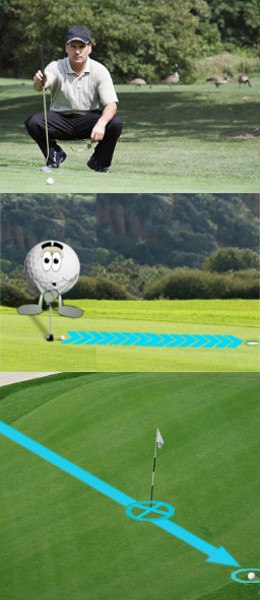Deciding whether to be a cautious or aggressive putter is a personal choice that can vary depending on the individual's playing style, skill level, and the specific circumstances of each putt. Here are a few factors to consider when making this decision:
- Reading the Green: Assess the slope, speed, and overall condition of the green. If the green is fast and undulating, it may be wiser to take a more cautious approach and focus on lag putting to leave yourself with easier second putts. If the green is relatively flat and slow, you might feel more comfortable being more aggressive with your putts.
- Length of Putt: The length of the putt can influence your approach. For longer putts, being more cautious and focusing on distance control may be beneficial to avoid leaving yourself with a difficult comeback putt. On the other hand, if the putt is relatively short, you might consider being more aggressive and aiming to hole it.
- Confidence and Skill Level: Consider your own confidence and skill level as a putter. If you have a high level of confidence in your putting stroke and feel comfortable with aggressive putts, you may choose to take more risks. However, if you struggle with consistency or have doubts about your ability to make aggressive putts consistently, a more cautious approach might be more suitable.
- Course Conditions and Situation: Assess the overall course conditions, the importance of the putt in the context of the game or competition, and your current score. These factors can influence your decision-making. For example, if you're playing in a high-stakes tournament and need to make up strokes, you might choose to be more aggressive. Conversely, if you're in a comfortable lead and want to avoid unnecessary risks, a cautious approach could be more appropriate.
- Personal Preferences: Ultimately, it's important to consider your own playing style and preferences. Some golfers naturally lean towards a more aggressive approach, while others prefer a cautious and methodical style. Experiment with different approaches during practice rounds to determine which strategy suits you best.
It's worth noting that finding the right balance between caution and aggression is often the key. Being overly cautious can lead to tentative strokes and missed opportunities, while being too aggressive can result in erratic putting and more three-putts. Regular practice, experience, and learning from your own performance will help you develop a better understanding of when to be cautious and when to be aggressive on the greens.
While trying to decide if you are going to be a cautious or aggressive putter, you might want to keep these few tips in mind.
- Think about local green conditions. If you play golf in an area which typically allows courses to keep their greens fast, it might be tough to maintain an aggressive style of play with your putter. Quick greens will cause your aggressive putts to roll out even farther, especially when playing down a hill.
- On the other hand, if you usually face slow greens, putting with an aggressive style will be a natural fit. Since most golfers play the majority of their rounds on just a handful of courses – or even just one course – it makes sense to tailor your putting method to your local conditions.
- Positioning is critical for aggressive putters. If you are going to putt aggressively, it is especially important that you manage to position your ball below the hole more often than not. If you can play intentionally to the low side on a regular basis, you can be aggressive putting back up the hill without too much worry of having the ball get away from you.
- Of course, even if you are a conservative putter, it is still a good idea to play to the low side whenever you can.
- Take your time on second putts. This is another tip which relates mostly to aggressive putters. If you let the ball race past the cup time and time again, you are going to deal with a lot of tricky comeback attempts.
- Rather than rushing into those putts, the better plan would be to take your time and collect your thoughts before proceeding. Mark the ball, read this short putt, and pick out a line. Then, make a smooth stroke and knock the ball right into the middle of the cup. It will take a few extra moments to reset yourself for these comeback putts, but that time will be well spent when you avoid three putt greens.
It’s up to you to decide how you want to approach your putts. Putting aggressively has its benefits, as we’ve seen in this article, but so too does playing it safe. The right plan for your game is the plan which yields the best results over the long run. Once you have decided how you will putt, don’t give up on your plan just because you have a bad round or two. Your confidence should grow over time, and your average score should come down as a result.

 Deciding whether to be a cautious or aggressive putter is a personal choice that can vary depending on the individual's playing style, skill level, and the specific circumstances of each putt. Here are a few factors to consider when making this decision:
Deciding whether to be a cautious or aggressive putter is a personal choice that can vary depending on the individual's playing style, skill level, and the specific circumstances of each putt. Here are a few factors to consider when making this decision:



